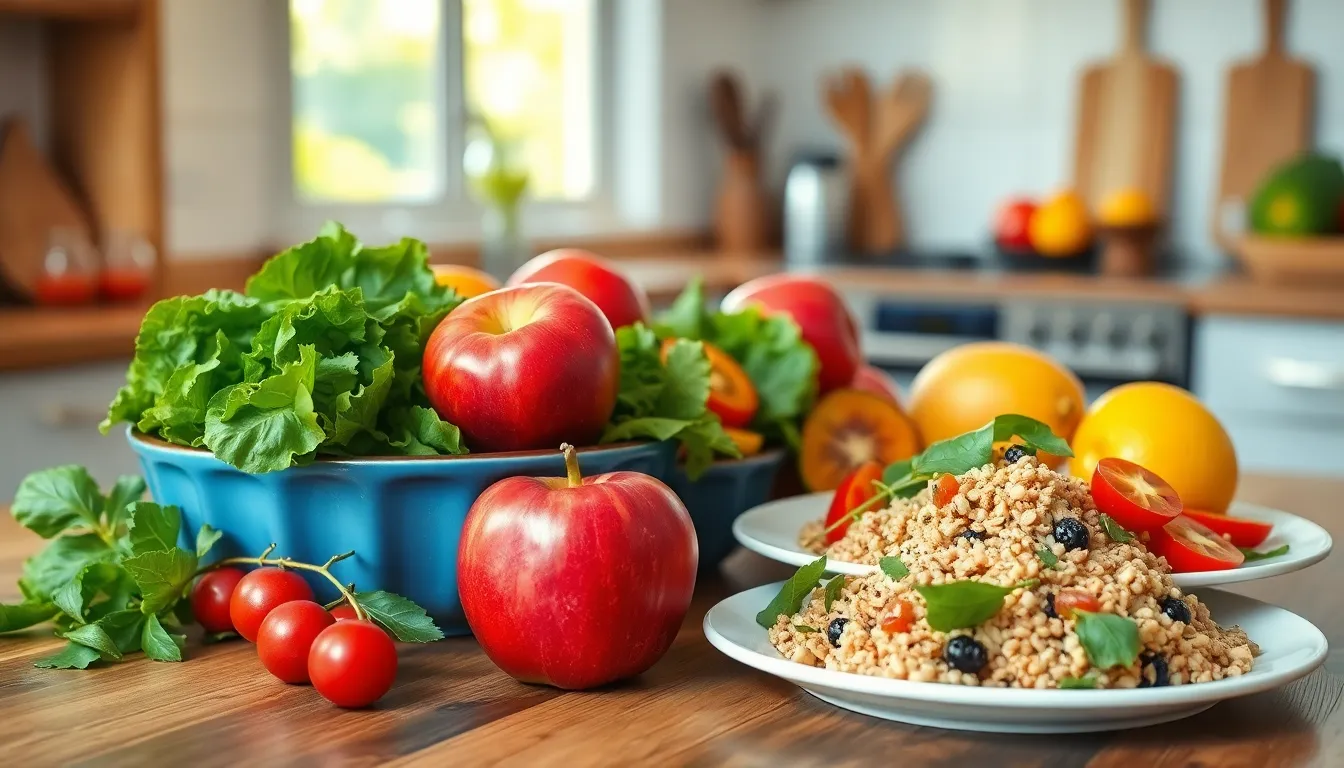In a world full of fast food temptations and sugary snacks, clean eating might sound like a diet plan designed by a kale-loving rabbit. But fear not! Embracing clean eating doesn’t mean giving up on flavor or fun. It’s all about choosing whole, unprocessed foods that nourish the body and keep those pesky cravings at bay.
Imagine biting into a juicy apple instead of a candy bar or savoring a hearty quinoa salad instead of a greasy burger. With a clean eating guide, transforming your meals into something vibrant and delicious is easier than you think. So grab your apron and get ready to whip up dishes that’ll make your taste buds dance while your waistline thanks you. Clean eating is not just a trend; it’s a lifestyle that can leave you feeling energized and fabulous.
Table of Contents
ToggleWhat Is Clean Eating?
Clean eating focuses on consuming whole, unprocessed foods that provide essential nutrients. This approach encourages individuals to choose fresh fruits, vegetables, lean proteins, and whole grains over processed alternatives. It prioritizes foods with minimal ingredients, allowing the body to efficiently absorb vital nutrients.
Processed foods, filled with additives and unhealthy fats, can contribute to cravings and sluggishness. By avoiding these, individuals experience increased energy and improved satisfaction after meals. Clean eating isn’t about deprivation; it celebrates flavorful and nutritious ingredients that enhance meals.
Eating clean includes items like leafy greens, berries, nuts, and legumes. These foods offer various health benefits, including antioxidants, fiber, and essential vitamins. Opting for home-cooked meals using fresh ingredients often leads to better nutritional outcomes than fast food or takeout.
Planning meals makes clean eating more manageable. Preparing dishes in advance allows for the incorporation of diverse ingredients and flavors. Individuals can experiment with spices and herbs to enhance taste without relying on unhealthy sauces or dressings.
Keeping hydrated supports clean eating efforts. Water plays a crucial role in digestion, energy levels, and overall health. Choosing water over sugary drinks complements a clean eating lifestyle, further reducing unnecessary calories and added sugars.
Clean eating embraces a sustainable lifestyle. Individuals who adopt this approach often develop a deeper connection with their food, understanding where it comes from and how it affects their bodies. This awareness fosters healthier choices, contributing to long-term well-being.
Benefits of Clean Eating


Clean eating offers multiple advantages, impacting overall health and energy levels significantly.
Improved Health
Clean eating reduces the risk of chronic diseases. By focusing on whole foods, individuals often increase their intake of essential nutrients. Nutrient-dense foods help maintain optimal weight, preventing obesity-related issues such as diabetes and heart disease. Fruits and vegetables provide antioxidants which combat inflammation, supporting a stronger immune system. Lean proteins contribute to muscle repair and growth, further promoting health. Including whole grains in daily meals helps regulate digestion, providing a steady release of energy. Ultimately, embracing clean eating encourages a healthier lifestyle, positively influencing long-term well-being.
Enhanced Energy Levels
Clean eating boosts energy levels throughout the day. Consuming unprocessed foods ensures a steady supply of vitamins and minerals, fueling the body effectively. Whole foods typically include complex carbohydrates, which release energy gradually, preventing energy crashes. Fresh fruits and vegetables hydrate while providing natural sugars that enhance stamina during physical activities. Lean proteins sustain energy levels by promoting muscle health and reducing fatigue. Hydration, often overlooked, plays a vital role in maintaining energy, making water consumption essential. Choosing clean sources of nutrition leads to increased vitality and productivity in daily activities.
Getting Started with Clean Eating
Clean eating involves making informed food choices that prioritize nutrition and nourishment. It’s about selecting whole, unprocessed foods that fuel the body effectively.
Essential Foods to Include
Fresh fruits provide vitamins, minerals, and fiber. Vegetables contribute essential nutrients and antioxidants. Lean proteins like chicken, fish, and legumes support muscle growth and repair. Whole grains such as quinoa, brown rice, and oats offer complex carbohydrates for energy. Nuts and seeds provide healthy fats, also adding crunch and flavor to meals. Incorporating these foods helps create satisfying and nutrient-dense meals.
Foods to Avoid
Processed foods often contain additives that can detract from overall health. Sugary snacks and beverages lead to energy crashes and poor nutrition. Refined grains such as white bread and pastries lack essential nutrients. Trans fats, often found in fried foods and margarine, may increase the risk of heart disease. Limiting sodium intake from packaged foods also benefits cardiovascular health. Avoiding these items fosters better health and supports a clean eating lifestyle.
Meal Planning Tips
Meal planning simplifies the clean eating journey. By preparing meals ahead, individuals minimize reliance on convenience foods.
Creating a Balanced Plate
A balanced plate is essential for a nutritious meal. Include a variety of colorful vegetables, ensuring half the plate consists of them. Incorporate a lean protein source, such as grilled chicken or tofu, for muscle support. Whole grains like quinoa or brown rice can occupy a quarter of the plate, providing sustained energy. Healthy fats from avocados or nuts add flavor and aid in nutrient absorption. Varying these components throughout the week promotes dietary diversity and maintains interest in meals.
Sample Meal Ideas
Sample meals exemplify how to integrate clean eating into everyday life. Start with a breakfast of overnight oats topped with berries and nuts. For lunch, try a quinoa salad mixed with chickpeas, spinach, and cherry tomatoes. A dinner option could include baked salmon with steamed broccoli and sweet potato. Snacks can feature carrot sticks with hummus or a handful of mixed nuts for an energy boost. Utilizing these ideas fosters healthy habits and supports the transition to clean eating.
Common Challenges and Solutions
Adapting to clean eating can present several challenges. Busy schedules often lead to reliance on processed foods, which lack nutritional value. Meal prep can help counteract this issue by providing ready-to-eat meals. Planning meals ahead reduces stress when hunger strikes and curbs the temptation of convenience foods.
Social situations frequently pose another hurdle. Dining out or attending gatherings can complicate maintaining a clean eating lifestyle. Choosing restaurants that prioritize fresh ingredients or bringing a healthy dish can ensure adherence to clean eating principles. Communicating dietary preferences to friends or family helps promote support when socializing.
Budgeting also presents concerns when shifting to a clean eating approach. Whole foods may seem more expensive than processed options. Shopping seasonal produce or buying in bulk enhances affordability while minimizing costs. Utilizing local farmers’ markets often provides fresher and more cost-effective choices.
Limited culinary skills may hinder the transition. Engaging in simple recipes encourages confidence and creativity in the kitchen. Online platforms offer a wealth of resources for learning cooking techniques and discovering new meals. Experimenting with herbs and spices adds flavor without compromising health.
Finally, cravings for sugary or processed snacks can derail clean eating efforts. Keeping healthy snacks like nuts, fruits, or yogurt readily available sustains energy levels and satisfies hunger. Understanding that cravings can diminish over time aids in overcoming temptations.
Addressing these challenges systematically equips individuals for a successful clean eating journey. By recognizing obstacles and implementing effective strategies, sustainable and nourishing eating patterns become attainable.



